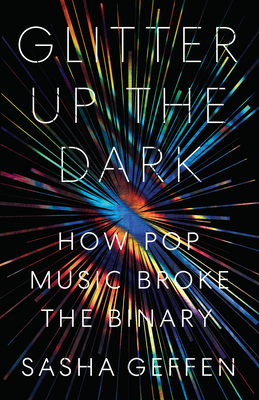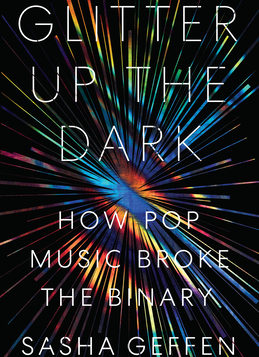 GLITTER UP THE DARK
GLITTER UP THE DARK
How Pop Music Broke the Binary
by Sasha Geffen
Univ. of Texas. 264 pages, $18.95
IN 1963, a cover of William Bell’s “Any Other Way” hit No. 2 on the Canadian pop charts. Sung by Nash-ville-born Jackie Shane, it’s a sultrier take than Bell’s, with powerful horns and a dramatic pause before each defiant recitation of the title. Shane also added her own twist when she sang: “Tell her that I’m happy, tell her that I’m gay.” Born in 1940, Shane self-identified as a woman beginning at the age of thirteen. It didn’t take long for her to become fed up with the Jim Crow South, and in 1959 she emigrated to Canada. Once she began performing, Shane wore wigs, makeup, sequins, and fur both onstage and off. She was mostly referred to in public as a man and with he/him pronouns. Shane had a fruitful career performing alongside Etta James, Jackie Wilson, and others, until she abruptly disappeared in 1971.
Jackie Shane was a trailblazer in the world of soul music for queer and trans people. (She re-emerged decades later, an anthology of her music was released in 2018, and she was nominated for a Grammy for Best Historical Album.) She lived authentically and unapologetically until her death in 2019. During her short career, she exhibited many of the characteristics Sasha Geffen examines in Glitter Up the Dark: How Pop Music Broke the Binary. In her dress, performances, and lyrics, Jackie Shane moved outside existing gender, sex, and racial roles. She lived and modeled what New York Times contributor Reggie Ugwu called “radical transparency” and was fiercely unapologetic about living her truth.
Sasha Geffen is a writer living in Colorado whose work focuses on gender and pop culture. As someone sitting at the intersection of gender identity and music royalty, they are exactly the person to write this volume. With just the right amount of juicy bits, this collection of twelve insightful essays examines how pop music shaped—and was shaped by—gender and sexuality over the last century.
Geffen’s main argument is that the binaries of sexuality and gender have always been permeable or even invisible in popular music, and they use the rest of the book to illustrate this point. They provide an engaging and thoughtful perspective on how gender and sexuality is performed and queered in every aspect of pop music including dress, vocalization, lyrics, movement and dancing, stage presence, performances on TV and in music videos, instrumentation, and more. Pop music allows for experimentation and outright transgression from essentialist gender and sex roles, including the rejection of masculinity, the destruction of the limitations of femininity, and inhabiting any in-between space that one finds authentic.
After an introduction in which Geffen makes the case that trans people have always existed and always made music, the book’s chapters are organized by genre, including glam, punk, electronic, grunge, disco, synthpop, Goth, and so forth. The queering of traditional masculine and feminine roles is a central theme of the book, as illustrated by artists such Kurt Cobain and Courtney Love, Iggy Pop, Annie Lennox, and Janet Jackson. A whole chapter is devoted to the Beatles and another to Prince.
While you may have never fancied the Beatles as queer icons, Geffen offers numerous illustrations of the ways in which the band and their closeted gay manager, Brian Epstein, challenged the normative heterosexuality and masculinity embodied by earlier stars like Elvis Presley. By putting the band in matching, longer hairstyles and tailored suits, Epstein used his gay gaze to soften or de-emphasize the standard markers of masculinity. Onstage and in films like A Hard Day’s Night, the Beatles displayed a sense of boyishness, vulnerability, and homoeroticism that appealed to teenage girls.
Prince’s androgyny is the focus of a chapter titled “Not a Woman, Not a Man.” Prince, like Joan Armatrading, Robert Smith of the Cure, and others, created and existed in a middle or third space along the continuum of sex and gender. But gender ambiguity was not new in the 1970s and ’80s. It had previously been embodied by Big Mama Thornton, Sister Rosetta Tharpe, Little Richard, Jackie Shane, Mick Jagger, and many others. But Prince embraced his in-between space both onstage and in his daily life; it wasn’t just a stage persona. Prince’s creativity was inextricably bound to his exploration and performance of gender and sexuality. Geffen includes many other queer, trans, and androgynous pop icons, such as Patti Smith, kd lang, Grace Jones, David Bowie, Alice Cooper, LaBelle, Donna Summer, Wendy Carlos, Janelle Monae, Bikini Kill, Tracy Chapman, The Ramones, and Missy Elliott, to name a few.
An interesting subtheme of this book is the importance of technology in pop music. Once associated with masculinity, synthesizers and other machines allowed for voices to be manipulated, for gendered bodies to remain unseen, and for the adaptability that’s especially important for queer and trans musicians. Pop music has often turned to the otherworldly when pushing the limits of gender. Being queer was akin to being an alien, and musicians such as David Bowie used this status to transcend masculinity’s limits. Bowie, Prince, and artists such as Iggy Pop, Alice Cooper, Gladys Bentley, and Patti Smith played with androgyny and flipped the gender binary with the clothes and hairstyles they wore.
Like gender, standardized notions of time are also challenged by pop music. Hip hop, for instance, grew from marginalized communities whose notions of time were largely based on the neglect of mainstream white existence. These communities were faced with criminalization, unemployment, or punching a time clock; they were limited in leisure time and resources. Hip hop, and specifically techniques like scratching and beatbox, exemplify the creative manipulations of technology and time to push back on and exert agency within systems of oppression. Though hip hop has always been dominated by a masculine ethos, women like MC Lyte, Queen Latifah, Monie Love, and Missy Elliott have challenged stereotypes and misogyny to invert notions of femininity and patriarchy.
One of the book’s many strengths is its exploration of how race intersects with gender and sexuality in pop music. Geffen doesn’t shy away from the fact that white artists stole music and mannerisms from black artists or that black musicians and performers had been challenging oppressive mores and traditions forever. For instance, Geffen names the problematic whiteness and white feminism of Riot Grrrl and notes that the Beatles’ success was built on the repackaging of black artists’ innovations. While this is a book focused on gender and sexuality, its intersectional approach to analysis is a breath of fresh air and should be used as a model for other white writers looking to offer critical examinations of issues surrounding gender and sexuality. Race cannot be ignored in these conversations.
While Geffen could hardly include all of the apt examples of the queering of pop music, there are a few disappointing exclusions. It would have been interesting to hear about Debbie Harry’s or Melissa Etheridge’s influences, for instance. The exclusion of Joan Jett and the Runaways is a serious oversight given Jett’s importance as an artist who blasted gender stereotypes. These omissions aside, this volume is a powerhouse of necessary examinations of gender and sexuality in pop music. With it, Geffen provides a well-researched and highly readable addition to music literature, showing definitively how pop music has always been queer, challenging patriarchy and gender roles, and how it has been a space of refuge and revolution for queer and trans artists.
Karla J. Strand is a freelance writer and librarian based in Madison, WI.






